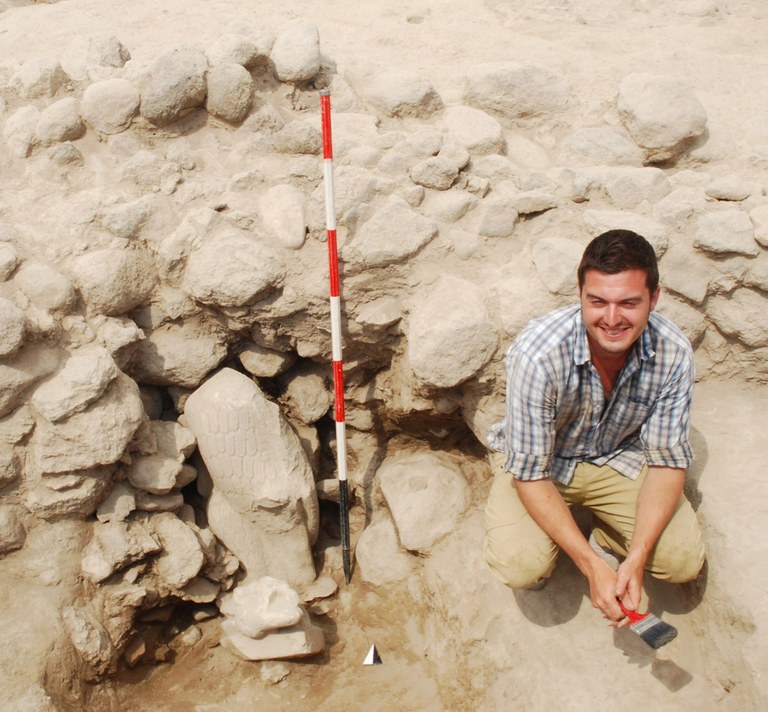Kınık Höyük: The Eagle Has Perched
This article by Diane Bennett first appeared in ISAW Newsletter 25 (Fall 2019).
 ISAW PhD student Nathan Lovejoy upon exposure of the Marble Eagle Statue
The 2019 excavation season at the site of Niğde Kınık Höyük (Turkey) revealed more about the Late Hellenistic occupation of the site. Excavations of the northern portion of the citadel’s summit (Operation E) during the last two campaigns focused on a monumental, stone-paved plaza opening south of the Achaemenid and Hellenistic citadel walls. This year’s investigations revealed a series of stone and mudbrick architectures located at the south-east limits of the plaza. Built above the plaza’s paved floor, these walls attest to active building activity and to various phases of reconfiguration that reshaped this public space throughout the Hellenistic period.
ISAW PhD student Nathan Lovejoy upon exposure of the Marble Eagle Statue
The 2019 excavation season at the site of Niğde Kınık Höyük (Turkey) revealed more about the Late Hellenistic occupation of the site. Excavations of the northern portion of the citadel’s summit (Operation E) during the last two campaigns focused on a monumental, stone-paved plaza opening south of the Achaemenid and Hellenistic citadel walls. This year’s investigations revealed a series of stone and mudbrick architectures located at the south-east limits of the plaza. Built above the plaza’s paved floor, these walls attest to active building activity and to various phases of reconfiguration that reshaped this public space throughout the Hellenistic period.
In the Late Hellenistic to Early Roman period, a portion of the plaza’s eastern floor was destroyed, most probably as the result of alluvial events that washed down building debris and mud from the höyük’s top. A large portion of the destroyed paved floor (over 5 meters wide) was completely removed and the preexisting layers below it were cut to accommodate a series of roughly circular pits.
A team led by ISAW PhD student Nathan Lovejoy in 2018 excavated the northernmost pit, which partially cut the fortification walls. It contained a marble statue of an eagle perched on the head of a mountain goat (H. 106 cm) with minimal damage. The discovery of the Marble Eagle Statue received world wide attention.
 The Eagle Marble Statue on its tuff basement in the permanent collection of the Niğde Museum
A team led by ISAW Research Associate Roberta Casagrande-Kim excavated a second pit this year. Inside, carefully laid on its back, was a second, slightly smaller (H. 75 cm) eagle, also perched on a mountain goat. Perfectly preserved, the statue retains the original iron tenon used to insert it on a base (cover photo). Next to it, four fragmentary lines of Greek were inscribed on part of a base of another statue, now lost. The text is currently being studied by ISAW Professor Emeritus Roger Bagnall and ISAW PhD candidate Georgios Tsolakis; a preliminary analysis includes reference to the cult of Zeus at the site.
The Eagle Marble Statue on its tuff basement in the permanent collection of the Niğde Museum
A team led by ISAW Research Associate Roberta Casagrande-Kim excavated a second pit this year. Inside, carefully laid on its back, was a second, slightly smaller (H. 75 cm) eagle, also perched on a mountain goat. Perfectly preserved, the statue retains the original iron tenon used to insert it on a base (cover photo). Next to it, four fragmentary lines of Greek were inscribed on part of a base of another statue, now lost. The text is currently being studied by ISAW Professor Emeritus Roger Bagnall and ISAW PhD candidate Georgios Tsolakis; a preliminary analysis includes reference to the cult of Zeus at the site.
New fragments of terracotta bovine figures were discovered adding to the corpus of zoomorphic and anthropomorphic terracottas found in the 2018 season, and confirming the presence of religious activities involving a local cult of Dionysus, in an area contiguous to the plaza.
With the generous support of TürkTraktör and under the aegis of Dr. Fazıl Açıkgöz, Director of the Niğde Archaeological Museum and of the Ministry of Culture and Tourism, in 2019 the Marble Eagle Statue was restored and is now installed at the Niğde Museum in the permanent collection.
The 2019 results of the excavations of the Late Hellenistic remains at Kınık Höyük as well as the installation of the two eagle statues at the museum had wide coverage in the media in Turkey.
The Kinik Hoyuk excavation is the result of joint efforts of ISAW and the University of Pavia’s Department of Humanities under the direction of Professor Lorenzo d’Alfonso (ISAW). Generous funding is provided by these Institutions, as well as the Italian Ministry of Foreign Affairs, while the local Turkish authorities, especially the Special Administration of the Niğde Province and the village of Yeşilyurt, provides fundamental logistic support. The excavations and study of the classical remains at the site is directed by Dr. Roberta Casagrande-Kim, ISAW Research Associate, by the project’s Vice Director, Prof. Burak Yolaçan, Dokuz Eylül University, and by Prof. Maria Elena Gorrini, University of Pavia.